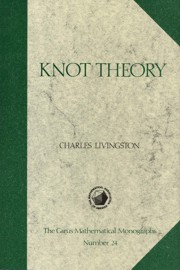Book contents
- Frontmatter
- ACKNOWLEDGEMENTS
- PREFACE
- Contents
- Chapter 1 A CENTURY OF KNOT THEORY
- Chapter 2 WHAT IS A KNOT?
- Chapter 3 COMBINATORIAL TECHNIQUES
- Chapter 4 GEOMETRIC TECHNIQUES
- Chapter 5 ALGEBRAIC TECHNIQUES
- Chapter 6 GEOMETRY, ALGEBRA, AND THE ALEXANDER POLYNOMIAL
- Chapter 7 NUMERICAL INVARIANTS
- Chapter 8 SYMMETRIES OF KNOTS
- Chapter 9 HIGH-DIMENSIONAL KNOT THEORY
- Chapter 10 NEW COMBINATORIAL TECHNIQUES
- Appendix 1 KNOT TABLE
- Appendix 2 ALEXANDER POLYNOMIALS
- REFERENCES
- INDEX
Chapter 5 - ALGEBRAIC TECHNIQUES
- Frontmatter
- ACKNOWLEDGEMENTS
- PREFACE
- Contents
- Chapter 1 A CENTURY OF KNOT THEORY
- Chapter 2 WHAT IS A KNOT?
- Chapter 3 COMBINATORIAL TECHNIQUES
- Chapter 4 GEOMETRIC TECHNIQUES
- Chapter 5 ALGEBRAIC TECHNIQUES
- Chapter 6 GEOMETRY, ALGEBRA, AND THE ALEXANDER POLYNOMIAL
- Chapter 7 NUMERICAL INVARIANTS
- Chapter 8 SYMMETRIES OF KNOTS
- Chapter 9 HIGH-DIMENSIONAL KNOT THEORY
- Chapter 10 NEW COMBINATORIAL TECHNIQUES
- Appendix 1 KNOT TABLE
- Appendix 2 ALEXANDER POLYNOMIALS
- REFERENCES
- INDEX
Summary
The field of mathematics called algebraic topology is devoted to developing and exploring connections between topology and algebra. In knot theory, the most important connection results from a construction which assigns to each knot a group, called the fundamental group of the knot. Knot groups will be developed here using combinatorial methods. An overview of the general definition of the fundamental group is given in the final section of the chapter.
The fundamental group of a nontrivial knot typically is extremely complicated. Fortunately, its properties can be revealed by mapping it onto simpler, finite, groups. The symmetric groups are among the most useful finite groups for this purpose. This chapter begins with a review of symmetric groups. Following that, it is shown how a symmetric group can provide new means of studying knots. The rest of the chapter is devoted to studying the connection between groups and knots more closely.
Symmetric Groups
The discussion of symmetric groups that follows focuses on a particular example, S5. The reader will have no trouble generalizing to Sn, and is asked to do so in the exercises. Several results that will be used later are described in the exercises also.
Let T denote the set of positive integers, {1, 2, 3, 4, 5}. Recall that a permutation of T is simply a one-to-one function from T to itself. There are 5! = 120 such permutations.
- Type
- Chapter
- Information
- Knot Theory , pp. 83 - 108Publisher: Mathematical Association of AmericaPrint publication year: 1993



